How Can You Analyze Your Performance In Badminton Training And Competition? (Malaysia & Singapore)
As a badminton coach working with players from Malaysia and Singapore, i see many of them train very hard but rarely sit down to review what actually happened in training or competition. Without simple, clear analysis, they repeat the same mistakes and feel stuck, even after years. This guide teaches players and parents in Setapak, Wangsa Maju, Selayang, Kepong, Cheras and surrounding areas how to analyse badminton performance step by step in both training sessions and matches using simple methods like notes, statistics, video review and coach feedback.
A certified badminton coach in Kuala Lumpur and Singapore explains how to analyze your training results and competition performance so you can see real progress instead of guessing what went wrong or right.

Core Area #1
Why Should You Analyze Training And Competition Performance?
At ST Badminton Academy, our certified badminton coaches work with kids aged 4 and above, school team players, serious juniors and working adults in Malaysia and Singapore who want to see clear improvement. Many players train regularly but do not understand why they win or lose, why certain shots fail under pressure, or where their real weaknesses lie. Performance analysis helps you move from guessing to knowing.
Without proper review of training sessions and matches, players repeat the same unforced errors for months or years. Simple analysis shows patterns you miss in the moment. It helps you see whether your footwork improved, whether your backhand clear became more consistent, or whether your mental focus breaks down when the score is close.
For families in Setapak, Wangsa Maju, Selayang and nearby areas who invest time and effort driving to training, analysis ensures that effort translates into measurable results. Players across Singapore, from Jurong to Hougang, benefit from understanding exactly what happened in each session and each tournament match.
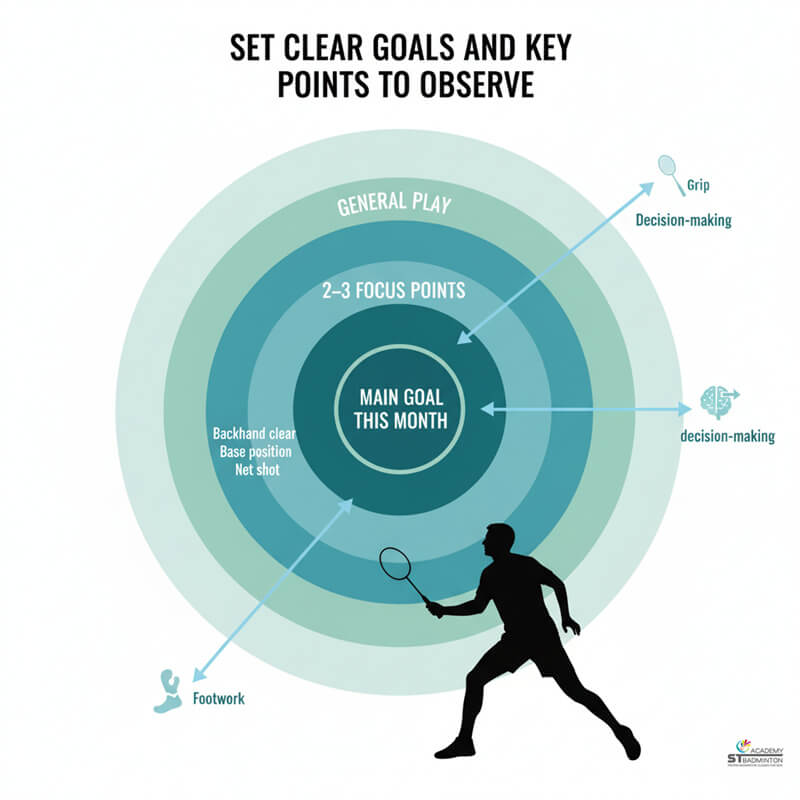
Core Area #2
Set Clear Goals And Key Points To Observe
Before you can analyze your performance, you need simple goals. Players at ST Badminton Academy learn to pick two or three focus points for each session rather than trying to watch everything at once. Examples include reducing unforced errors in rallies, improving net shot consistency, moving faster to the backhand corner, or maintaining focus during close scores.
These goals should cover technical aspects like grip and footwork, tactical decisions like when to attack or defend, physical elements like speed and stamina, and mental factors like attitude under pressure. For young children in Kepong, Cheras and Ampang, goals might be as simple as completing ten good serves in a row. For serious juniors and adults from Bishan, Ang Mo Kio or Tampines in Singapore, goals become more specific around match situations and shot placement.
Our certified coaches help players identify which areas need the most attention and create realistic targets that can be tracked week by week across training sessions and competitions.
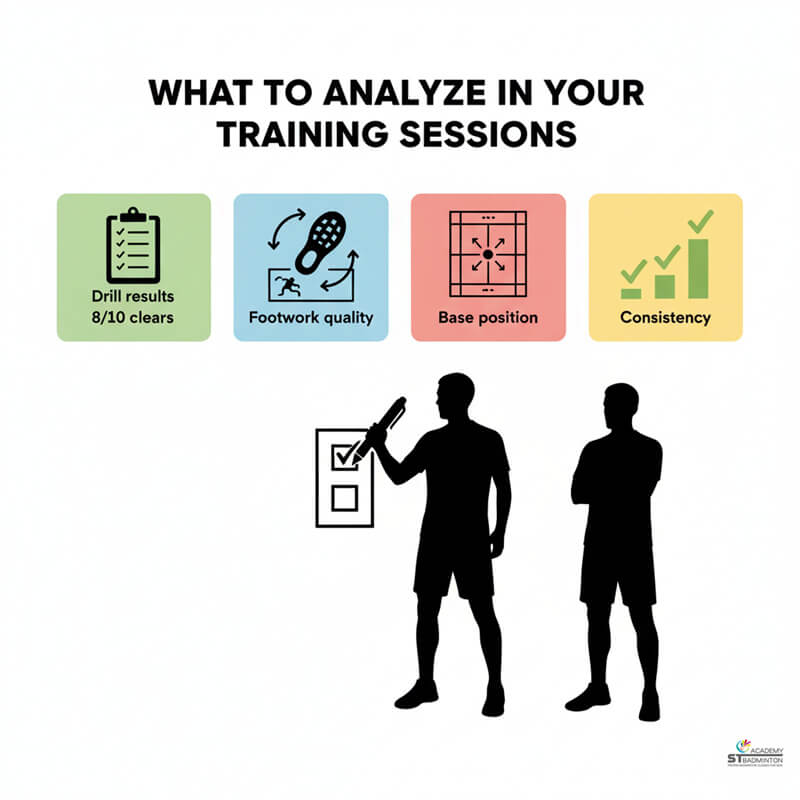
Core Area #3
What To Analyze In Your Training Sessions
Training analysis focuses on quality over quantity. At ST Badminton Academy in Kuala Lumpur, players note drill results such as how many clear shots in a row landed in the correct zone, how many net shots fell into the tape versus over, and how consistent their footwork patterns remained throughout the session. Simple tracking shows whether you improved compared to last month.
Observe your base position and recovery after each shot. Are you always late getting back to center, or do you stand too close to the net and struggle with rear court defense? Track basic statistics like successful serves out of ten attempts or rallies won when starting with a long high serve versus a short serve.
Our certified coaches in Setapak and across Singapore guide players to focus on one or two weaknesses each month, using simple notebook entries or phone notes to compare progress. For kids and juniors from Sentul, Gombak, Danau Kota and Melati Utama, parents can help record these observations after each class, making analysis a shared learning activity.
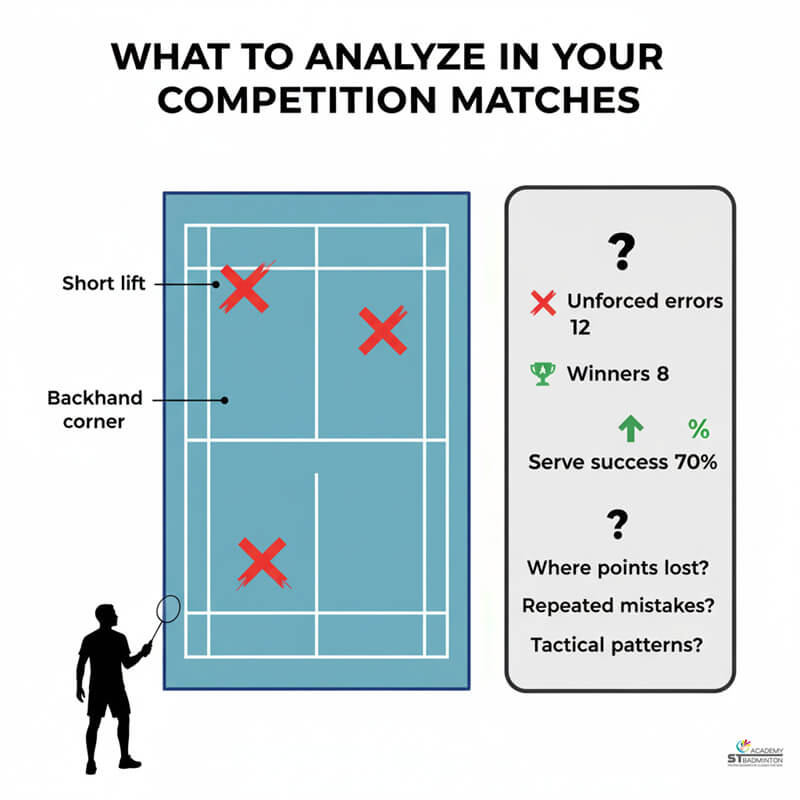
Core Area #4
What To Analyze In Your Competition Matches
Match analysis gives clearer insights than training because competition reveals patterns under pressure. Players should track unforced errors versus forced errors, noting which mistakes happen most often such as short lifts, backhand rear court weakness, or net shots into the tape. Record serve and return patterns to see if you win more points when serving long or short.
Observe rally phases where you gain or lose several points in a row. Many matches in school leagues, club games or tournaments across Kuala Lumpur and Singapore are decided by who makes fewer unforced errors rather than who hits the hardest smash.
After each game, write down three technical observations and three tactical notes. For instance, technical might include weak forehand net under pressure, while tactical could note that you attacked too early before opponent was out of position. Understanding these patterns helps your certified coach at ST Badminton Academy focus the next training cycle on the real issues affecting your results.
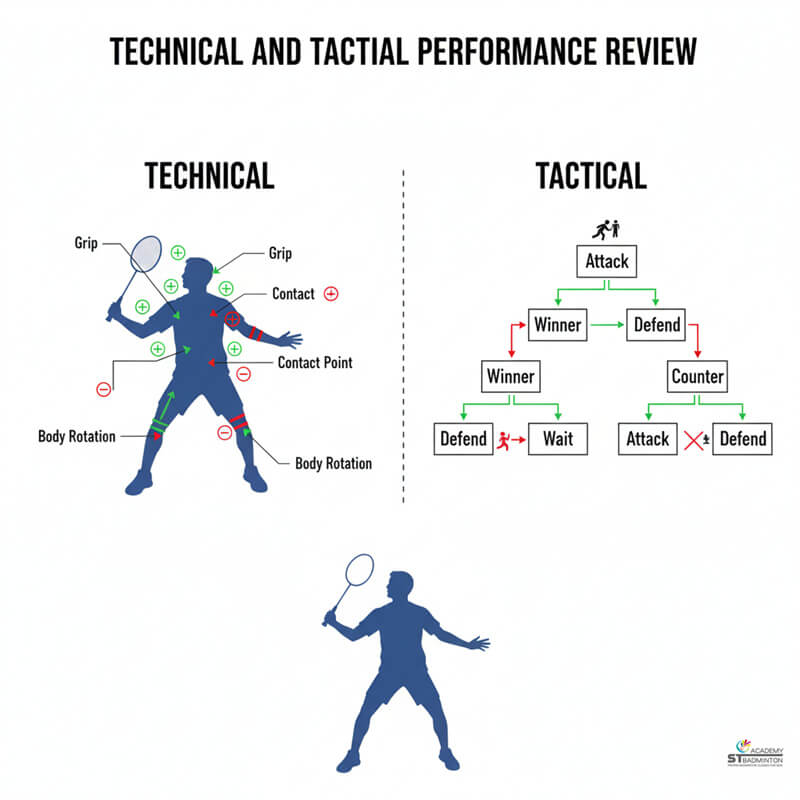
Core Area #5
Technical And Tactical Performance Review
Technical analysis examines shot quality including the length and height of your clear, tightness of net shots, smash placement, and consistency of your lift. Look at timing, contact point and body position for each stroke type. Are you always reaching too late for backhand clears, or do you rush your forehand net contact and push the shuttle too high?
Tactical analysis focuses on decision making. Did you attack when your opponent was still in good position, or did you wait for a weak return? Did you defend patiently when under pressure, or panic and lift too short? Review your base position and movement efficiency to see if you waste energy or arrive late to certain areas of the court.
Players from Ampang, Petaling Jaya, Subang Jaya, Puchong and across Singapore should write down three technical and three tactical observations after each matchplay session or competition. Share these notes with your certified coach so training drills can target the exact weaknesses that appeared under match pressure.
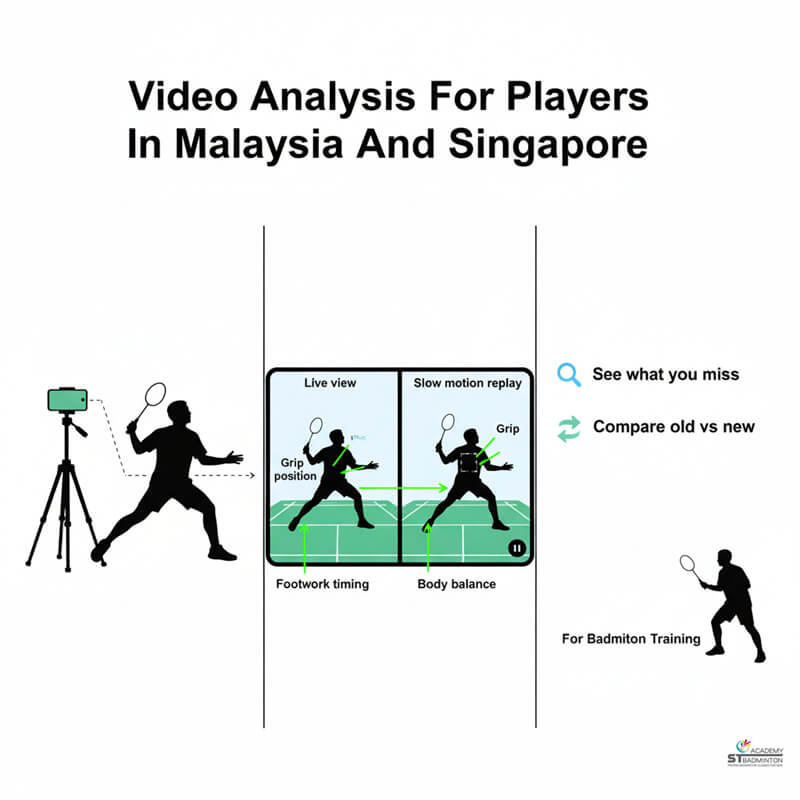
Core Area #6
Using Simple Stats And Notational Analysis
You do not need professional software to track badminton performance. Simple methods work well for players of all ages and levels across Malaysia and Singapore. Use tally marks on paper or a phone notes app to count winners, unforced errors and key shot types during practice matches. Record how many rallies you win when you serve versus when you receive.
Count how many points you lose from the same repeated mistake such as short lifts or weak backhand clears. Over several weeks, these simple numbers reveal clear patterns that guide your next training focus. For younger players in Setapak, Cheras, Yishun, Hougang or Sengkang, parents can help note these points after each match.
Compare your stats month by month to see if unforced errors decreased or if your serve success rate improved. Our certified coaches at ST Badminton Academy use these straightforward tracking methods to help all players from beginners to serious competitors see exactly where effort is producing results and where more work is still needed.

Core Area #7
Video Analysis For Players In Malaysia And Singapore
Recording your training or matches on a phone helps you see what really happens versus what you think happens. Set up your phone on a tripod or ask someone to record from the gallery with your coach’s permission. Watch one game at a time, focusing on a single theme such as footwork patterns, base position, or body language under pressure.
Use slow motion or pause to examine timing, contact point and movement efficiency. Send short clips to your certified coach for feedback between sessions. Compare old and new videos recorded three or six months apart to see visible improvement in movement stability, stroke mechanics and court awareness.
Players across Kuala Lumpur, from Kepong to Ampang, and across Singapore, from Clementi to Tampines, can use video to spot habits they never noticed before such as standing too upright, arriving late to the shuttle, or poor recovery after attacking shots. Video makes analysis concrete and easier to discuss with coaches and training partners.
FAQs: Analyzing Badminton Performance In Training And Competition
Here are answers to common questions from players and parents in Malaysia and Singapore about analyzing badminton performance in training sessions and matches.
How can my child analyze their badminton performance after training in Setapak or Wangsa Maju, Kuala Lumpur?
Children can start with simple observations like how many good clears they completed in a row or how many net shots went into the tape. Parents can help younger players write down two or three things that went well and one area to improve next time. At ST Badminton Academy, our certified coaches guide kids aged 4 and above in Kuala Lumpur to focus on one clear goal per session, making analysis positive and age appropriate.
What should I write down after a badminton match in a school league or club game in Singapore?
Note the score, opponent name, and key patterns such as how many unforced errors you made, which shots caused problems, and whether you won more points when serving or receiving. Write three technical observations like weak backhand rear court and three tactical notes such as attacked too early before opponent was out of position. Players from Bishan, Hougang, Sengkang and other Singapore areas can share these notes with their certified coach to adjust the next training cycle.
Do I need professional software to analyze my badminton games and training sessions in Malaysia?
No. Simple methods like tally marks on paper or phone notes work well for tracking winners, unforced errors and shot types. You can record how many rallies you win when you serve versus receive and count repeated mistakes over several weeks. Players in Kuala Lumpur and across Malaysia benefit from straightforward tracking that shows clear patterns without needing expensive technology or complicated spreadsheets.
How often should I review my badminton progress with my coach at ST Badminton Academy in KL?
Regular players should discuss performance with their certified coach every two to four weeks, comparing stats and observations from training and matches. After major competitions or school tournaments, schedule a review session within a few days to analyze what happened while details are still fresh. Players from Setapak, Cheras, Ampang and nearby areas who train consistently benefit from monthly check-ins to adjust goals and training focus.
Can young beginners also learn simple performance analysis methods at badminton training in Kuala Lumpur?
Yes. At ST Badminton Academy Malaysia, even kids aged 4 and above learn basic self-review by noting whether their grip felt comfortable, whether they moved earlier to the shuttle, or whether they remembered to return to base position. Parents help guide these simple observations. As children grow older and join school teams, they gradually track more detailed statistics and tactical patterns with support from our certified coaches.
What are the four main areas to analyze in badminton performance for players in Singapore and Malaysia?
Review technical aspects like grip, swing and footwork, tactical choices such as when to attack or defend, physical elements including stamina and movement speed, and mental factors like focus and body language under pressure. Players can rate each area from one to five and update every few months to track trends. This four-area framework helps serious juniors and adults in Singapore and Malaysia see balanced progress across all performance dimensions.
How can video analysis help improve my badminton technique and decision making in KL?
Recording your matches or training on a phone lets you see habits you never noticed such as poor base position, late footwork or weak contact points. Watch one game focusing on one theme, use slow motion to check timing and body position, and compare old videos with new ones to see improvement over months. Players in Kepong, Petaling Jaya, Subang Jaya and other KL areas can send short clips to their certified coach for specific feedback.
How do I turn performance analysis into the next training plan at ST Badminton Academy Malaysia?
After each tournament or monthly review, choose two or three main weaknesses to focus on for the next training cycle. Share your match notes and stats with your certified coach who will design drills and footwork sessions targeting those specific issues. After a few weeks, check again to see if the same mistake still appears or has reduced. This cycle of analysis, focused training and re-evaluation produces clear measurable improvement.
How will I know if my performance analysis is working and helping me improve at badminton in Singapore?
Compare your stats and observations from three to six months ago with current results. You should see fewer repeated mistakes, improved consistency in key shots, and better decision making under pressure. Players in Jurong, Bukit Timah, Toa Payoh, Yishun and across Singapore who track performance regularly gain confidence because they understand exactly why results improved instead of hoping for luck or guessing what might work next time.
Performance Analysis Methods In Action




Review Technical, Tactical, Physical And Mental Areas
Balanced performance analysis covers all four dimensions of your badminton game. Our certified coaches help players from kids to serious adults in Kuala Lumpur and Singapore track progress across technical skills, tactical decisions, physical conditioning and mental focus to understand the full picture.
| Review Area | Playing Without Analysis | Using Systematic Analysis CLEAR |
|---|---|---|
| Understanding Results | You guess why you won or lost. Repeat same mistakes for months without noticing patterns. | You know exactly which unforced errors, tactical choices and technical weaknesses affected results. Adjust training focus based on facts. |
| Training Direction | Train everything randomly without clear priorities. Waste time on areas that are already strong. | Focus on two or three main weaknesses each cycle. Track drill results to confirm improvement over weeks and months. |
| Match Preparation | Hope for the best. No idea which situations cause most mistakes or point losses. | Review past matches to identify weak phases like backhand rear court or short lifts under pressure. Train specific scenarios. |
| Technical Development | Think your technique is fine because you train regularly. Cannot explain why shots fail under match pressure. | Compare video from three months ago with current footage. See clear improvement in footwork, contact point and body position. |
| Confidence Growth | Feel stuck even after years of training. Unsure whether effort produces real progress or just maintains current level. | Simple stats show serve success increased from 60% to 85%. Unforced errors decreased from 15 per game to 8. Confidence grows from clear evidence. |
| Coach Collaboration | Cannot explain to your coach what actually happened in training or matches. Rely only on coach observation during lessons. | Share detailed notes, stats and video clips with certified coach. Training becomes targeted because coach knows your exact weaknesses from competition. |
| Long Term Progress | Train for years without measurable improvement. Cannot identify whether footwork, tactics or mental focus needs most work. | Track performance in four areas: technical, tactical, physical, mental. Rate each one to five every few months to see trends and plan next steps. |
Learn Performance Analysis With Certified Coaches In Malaysia And Singapore
This guide explains how to analyze your badminton performance in training and competition using simple, practical methods that work for kids aged 4 and above, school team players, serious juniors and working adults in Malaysia and Singapore. ST Badminton Academy provides coaching that includes guided performance review, helping players from Setapak, Wangsa Maju, Selayang, Kepong, Cheras, Ampang and surrounding areas turn observations into focused training plans. Contact us to learn how systematic analysis can help you see clear progress instead of guessing what went wrong or right.




